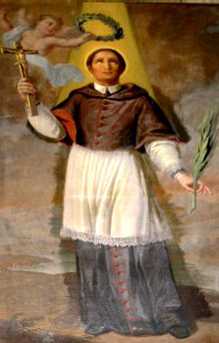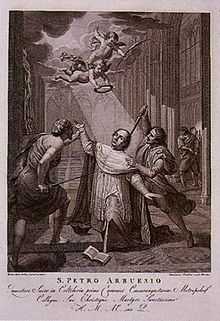Pedro de Arbués
| St. Pedro de Arbués, C.R.S.A. | |
|---|---|
 Depiction of Pedro de Arbués with the crown and palm of martyrdom. | |
| Religious, priest and martyr | |
| Born |
ca. 1441 Kingdom of Aragon |
| Died |
September 17, 1485 Zaragoza, Kingdom of Aragon |
| Venerated in |
Roman Catholic Church (Canons regular and the Roman Catholic Archdiocese of Zaragoza) |
| Canonized | 1867, Rome, Papal States, by Pope Pius IX |
| Major shrine |
Cathedral of the Savior, Zaragoza, Spain |
Pedro de Arbués, C.R.S.A. (c. 1441 – September 17, 1485), was an official of the Spanish Inquisition who was assassinated in the La Seo Cathedral of Zaragoza in 1485 in an alleged plot by conversos and Jews. He was very quickly venerated as a saint by popular acclaim, and his death greatly assisted the Inquisition and its Inquisitor General, Tomás de Torquemada, in their campaign against heresy and crypto-Judaism.
Arbués was canonized in 1867.
Life
Born in the region of Zaragoza, his father, a nobleman, was Antonio de Arbués, and his mother's name was Sancia Ruiz. He studied philosophy, probably at Huesca, but later went to Bologna, where in the Spanish college of St. Clement, part of the University of Bologna. He was regarded as a model of learning and piety, and was graduated in theology and law. Returning to Spain he became a member of the cathedral chapter of canons regular at La Seo, where he made his religious profession in 1474.
About that time Ferdinand and Isabella had obtained from Pope Sixtus IV a papal bull to establish in their kingdom a tribunal for searching out heretics, and especially Jews who after having received baptism had relapsed openly or secretly into Judaism; these were known as Marranos. Torquemada, in 1483, was appointed Grand Inquisitor for Castile and appointed Arbués as Inquisitor Provincial in the Kingdom of Aragon (1484).
On September 14, 1485, Arbués was assassinated in the cathedral as he was praying, even though he was wearing a helmet and chain mail. This was the consequence of the bad reception that the Inquisition had received in Aragón, where it was seen as an attack by the Crown on the fueros, the local laws and privileges. In particular, it appears that some of the most powerful families among the converted Jews - such as the Sánchez, Montesa, Paternoy, and Santángel families - considered themselves favorite victims of the Inquisition, and were implicated in the assassination. As a consequence, there arose a popular movement against the Jews; "nine were finally executed in persona, in addition to two suicides, thirteen burnings at the stake, and four punished for complicity", according to the account of the historian, Jerónimo Zurita y Castro.
Veneration

Honored as a martyr, Arbués' remains were entombed in a special chapel dedicated to his memory. He was canonized in 1867 by Pope Pius IX.
Arbués' canonization remains controversial. In 2001, Garry Wills, questioning Pius IX's motives, wrote: "In 1867, he canonized Peter Arbués, a 15th-century inquisitor famed for forcible conversion of Jews, and said in the canonization document, The divine wisdom has arranged that in these sad days, when Jews help the enemies of the church with their books and money, this decree of sanctity has been brought to fulfillment."[1]
The Jewish Encyclopedia states: "The zeal exhibited by Torquemada in his religious persecutions was emulated by Arbues, who in the first month of his office held two autos da fé, at which several Maranos were executed, and others were condemned to penance and loss of property." [2]
In contrast, the Catholic Encyclopedia states: "Peter performed the duties with zeal and justice. Although the enemies of the Inquisition accuse him of cruelty, it is certain that not a single sentence of death can be traced to him... The Marranos, however, whom he had punished hated and resolved to do away with him. One night while kneeling in prayer before the altar of Our Lady in the metropolitan church, where he used to recite the Office with his brother canons, they attacked him, and hired assassins inflicted several wounds from which he died two days after."[3]
Leonardo Sciascia in Morte dell'inquisitore (1967) writes that Arbués, along with Juan Lopez Cisneros (d. 1657), are "the only two cases of inquisitors who died assassinated".
See also
Notes
- ↑ Garry Wills, "The Popes Against the Jews: Before the Holocaust," New York Times, September 23, 2001. Retrieved from http://online.sfsu.edu/~rone/Religion/popesagainstjews.html.
- ↑ http://www.jewishencyclopedia.com/articles/1725-arbues-pedro
- ↑ CATHOLIC ENCYCLOPEDIA: St. Peter of Arbues
References
- Simon Whitechapel, Flesh Inferno: Atrocities of Torquemada and the Spanish Inquisition (Creation Books, 2003). ISBN 1-84068-105-5
 This article incorporates text from a publication now in the public domain: A. Allaria (1913). "St. Peter of Arbues". In Herbermann, Charles. Catholic Encyclopedia. Robert Appleton Company.
This article incorporates text from a publication now in the public domain: A. Allaria (1913). "St. Peter of Arbues". In Herbermann, Charles. Catholic Encyclopedia. Robert Appleton Company.- Pedro Arbues in the public domain Jewish Encyclopedia, Funk and Wagnalls, 1901 - 1906.
External links
-
 "Arbués, Pedro". New International Encyclopedia. 1905.
"Arbués, Pedro". New International Encyclopedia. 1905.
|